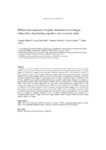| dc.contributor.author | Madrid, Antonio | |
| dc.contributor.author | Valls-Solé, Josep | |
| dc.contributor.author | Oliviero, Antonio | |
| dc.contributor.author | Cudeiro, Javier | |
| dc.contributor.author | Arias, Pablo | |
| dc.date.accessioned | 2017-04-17T11:55:42Z | |
| dc.date.issued | 2016-10-24 | |
| dc.identifier.citation | Madrid A, Valls-Solé J, Oliviero A, Cudeiro J, Arias P. Differential responses of spinal motoneurons to fatigue induced by short-lasting repetitive and isometric tasks. Neurosci. 2016;339:655-666 | es_ES |
| dc.identifier.issn | 0306-4522 | |
| dc.identifier.uri | http://hdl.handle.net/2183/18396 | |
| dc.description.abstract | [Abstract] Compared to isometric activities, the neural basis of fatigue induced by repetitive tasks has been scarcely studied. Recently, we showed that during short-lasting repetitive tasks at the maximal possible rate (finger tapping for 10 and 30 s), tapping rate and maximal voluntary contraction (MVC) force decrease at the end of finger tapping. We also observed larger silent periods (SP) induced by transcranial magnetic stimulation during MVC post finger tapping. However, if SP were induced by cervicomedullary stimulation (CMS) they remained unchanged. This suggested a supraspinal origin of fatigue for repetitive tasks. Nevertheless, CMS SP only partially explore spinal excitability; therefore, to evaluate a spinal origin of fatigue it is essential to know the features of the CMS-evoked potentials (CMEP). Herein, we evaluated (n = 15) the amplitude of the CMEP during MVC executed immediately (no gap) after a short-lasting finger tapping task; we also evaluated the compound muscle action potential (CMAP) so that the amplitude of the CMEP was expressed as a function of the CMAP amplitude. Indices of fatigue obtained during finger tapping were compared with those obtained during short-lasting maximal isometric tasks. While indices of excitability increased initially in both tasks, they decreased with the isometric task only when the task was prolonged to 30 s. We suggest that the inability to maintain increased levels of spinal excitability during task execution is a neurophysiological mark of fatigue. Our results suggest that the origin of fatigue induced by brief and fast repetitive tasks is not spinal. | es_ES |
| dc.description.sponsorship | Galicia. Consellería de Educación; 2007/000140-0 | es_ES |
| dc.language.iso | eng | es_ES |
| dc.publisher | Elsevier | es_ES |
| dc.relation.uri | http://doi.org/10.1016/j.neuroscience.2016.10.038 | es_ES |
| dc.rights | Atribución-NoComercial-SinDerivadas 3.0 España | es_ES |
| dc.rights.uri | http://creativecommons.org/licenses/by-nc-nd/3.0/es/ | * |
| dc.subject | Fatigue | es_ES |
| dc.subject | Repetitive movements | es_ES |
| dc.subject | Human | es_ES |
| dc.subject | Spinal cord | es_ES |
| dc.title | Differential responses of spinal motoneurons to fatigue induced by short-lasting repetitive and isometric tasks | es_ES |
| dc.type | info:eu-repo/semantics/article | es_ES |
| dc.rights.access | info:eu-repo/semantics/embargoedAccess | es_ES |
| dc.date.embargoEndDate | 2017-10-24 | es_ES |
| dc.date.embargoLift | 2017-10-24 | |
| UDC.journalTitle | Neuroscience | es_ES |
| UDC.volume | 339 | es_ES |
| UDC.startPage | 655 | es_ES |
| UDC.endPage | 666 | es_ES |






